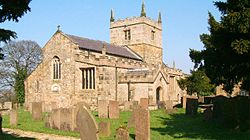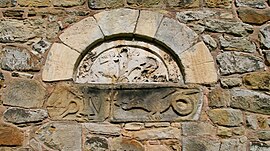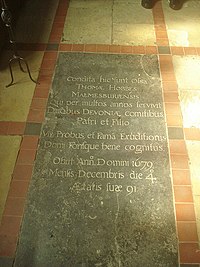Church of St John the Baptist, Ault Hucknall
| Church of St John the Baptist | |
|
Ault Hucknall, Derbyshire | |
|---|---|
| Status: | Parish church |
 St John the Baptist’s Church, Ault Hucknall | |
| Church of England | |
| Diocese of Derby | |
| Parish: | SK46746523 |
| Location | |
| Grid reference: | SK46746523 |
| Location: | 53°10’56"N, 1°18’7"W |
| History | |
| Built 11th century | |
| Information | |
St John the Baptist's Church, Ault Hucknall is the parish church, in the Church of England, of the tiny village of Ault Hucknall in Derbyshire.[1] It is originally of the 11th century, believed to by late Anglo-Saxon, with Norman additions, though the early work is largely visible only inside a Gothic interior.
This is the parish church for neighbouring Hardwick Hall, the magnificent house which though now in the hands of the National Trust was long the second seat of the Earls and Dukes of Devonshire, and the patronage of the family explains the grandeur that later ages gave to this ancient church. Hardwick Hall stands to the south.
The church is noted for its ornate Saxon and Norman carvings, and for being the final resting place of the great philosopher Thomas Hobbes, the founder of modern philosophy, who lived his last years as a guest of the Earl of Devonshire at Hardwick Hall.
The church is a Grade I listed building.[2]
The church is in a joint parish with St Andrew's Church, Glapwell; St Leonard's Church, Scarcliffe; and St Luke's, Palterton.
History

The church dates from the 11th century with 14th- and 15th-century features. It was restored between 1885 and 1888 by William Butterfield.
The church has a number of unusual or interesting features. The church itself has the appearance of a later Mediæval, perpendicular Gothic church. However it is much earlier from the 11th century. The narrow arch in the chancel is Anglo-Saxon, with a Normal chancel arch added, the latter ornamented with carvings illustrating the book of Genesis. The interior has a two-bay 11th century north arcade of plain unmoulded round arches (typical of Anglo-Saxon work) and with chamfered impost bands.
An unusual feature of the church is set not the west wall: a tympanum and a lintel dating from the 11th century, with carvings of the period. The lintel beneath shows a figure with a kite shield battling a dragon, while the ornate tympanum above appears to show a centaur-like figure battling another monster – it is said by some to represent Christ fighting the Leviathan (from an allegory by Gregory the Great). If so, its position is an amusing irony, so close to the tomb of Thomas Hobbes, whose master work is Leviathan.
Memorials

The church was patronised by the Cavendish family, the earls and later Dukes of Devonshire, from their second seat at Hardwick Hall. It contains notable monuments to:
- Anne Keighley, wife of William Cavendish, 1st Earl of Devonshire
- Thomas Hobbes (d. 1679)
Organ
The pipe organ was installed by Brindley & Foster around 1905. A specification of the organ can be found on the National Pipe Organ Register.[3]
| ("Wikimedia Commons" has material about Church of St John the Baptist, Ault Hucknall) |
References
- ↑ Nikolaus Pevsner: The Buildings of England: Derbyshire, 1953; 1978 Penguin Books ISBN 978-0-300-09591-3
- ↑ National Heritage List 1109001: Church of St John the Baptist (Grade I listing)
- ↑ "NPOR N00303". National Pipe Organ Register. British Institute of Organ Studies. http://www.npor.org.uk/NPORView.html?RI=N00303. Retrieved 23 April 2015.
